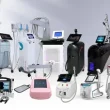Introduction
In today’s fast-evolving industrial landscape, precise monitoring and control of machinery are paramount. Sensor bearings are critical components that blend the traditional mechanical function of bearings with integrated sensors, providing vital data for predictive maintenance, performance optimization, and enhanced safety. Whether in manufacturing plants, automotive systems, or robotics, sensor bearings have become indispensable.
Definition
Sensor bearings are specialized bearings integrated with sensors that monitor parameters such as speed, rotation direction, temperature, or vibration directly at the bearing location. By combining mechanical support with real-time data collection, these bearings help enhance machine performance, enable predictive maintenance, and improve overall system reliability. Sensor bearings are commonly used in automotive, industrial, and aerospace applications where precise condition monitoring is critical.
What Are Sensor Bearings?
A bearing is a mechanical element that supports rotational or linear movement and lowers friction between moving parts. Traditional bearings focus purely on mechanical roles – supporting shafts, minimizing wear, and enabling smooth motion.
Sensor bearings, however, combine the mechanical functionality of bearings with embedded sensing technology. These sensors monitor parameters such as temperature, vibration, speed, and load in real-time, allowing early detection of potential faults. This smart integration aids in predictive maintenance, improving equipment reliability and preventing unexpected failures.
Why Are Sensor Bearings Important?
Machine downtime can lead to substantial financial losses, compromised safety, and production delays. Traditional maintenance methods, like scheduled or reactive maintenance, often either waste resources or respond too late to issues.
Sensor bearings enable condition-based monitoring (CBM), where maintenance is performed only when necessary, based on actual machine condition data. This reduces unnecessary downtime, extends the life of machinery, and optimizes maintenance costs.
Additionally, sensor bearings provide critical data for:
- Performance optimization: Understanding load and speed helps adjust operations for efficiency.
- Safety enhancement: Early detection of overheating or unusual vibrations prevents catastrophic failures.
- Automation: Sensor data can be integrated into automated control systems for adaptive responses.
Types of Sensor Bearings
Sensor bearings vary by the type of sensors embedded and their intended measurement parameters. Below are common types categorized by sensing capability:
1. Temperature Sensor Bearings
These bearings have temperature sensors inserted close to the bearing surface, usually thermocouples or RTDs. They monitor heat generated due to friction or lubrication issues.
- Function: Detect overheating that could indicate lubrication failure, excessive load, or misalignment.
- Applications: Wind turbines, compressors, electric motors, and pumps.
2. Vibration Sensor Bearings
Vibration sensors (usually accelerometers or piezoelectric sensors) measure vibration levels caused by imbalance, misalignment, or bearing wear.
- Function: Analysing vibration signatures can help spot faults early.
- Applications: Rotating machinery, gearboxes, and turbines.
3. Speed Sensor Bearings
These bearings have magnetic or optical sensors to measure shaft speed or rotational velocity.
- Function: Provide real-time speed data for control and monitoring.
- Applications: Automotive wheels, conveyor belts, and industrial drives.
4. Load Sensor Bearings
Load sensors measure the force exerted on the bearing, typically using strain gauges.
- Function: Monitor mechanical load to prevent overload or structural damage.
- Applications: Heavy machinery, cranes, and construction equipment.
5. Multi-Sensor Bearings
Some advanced sensor bearings combine multiple sensor types (temperature, vibration, speed) to provide comprehensive monitoring.
- Function: Integrated data analytics for better predictive maintenance.
- Applications: Aerospace, robotics, and smart manufacturing systems
How Do Sensor Bearings Work?
The core principle behind sensor bearings is the integration of micro-sensors within the bearing assembly. These sensors detect physical parameters and convert them into electrical signals. The information is subsequently sent to control units or monitoring systems.
Key components and process:
- Sensors: Miniaturized in size and strengthened to resist challenging conditions.
- Signal Conditioning: Filtering and amplification to improve the quality of the data.
- Data Transmission: Wired or wireless communication protocols send data to external devices.
- Data Analysis: Software platforms analyze trends, detect anomalies, and predict failures.
For example, a vibration sensor bearing installed in a motor shaft continuously measures vibration patterns. If abnormal vibration levels are detected, the system triggers alerts, allowing maintenance teams to intervene before damage occurs.
Applications of Sensor Bearings
Sensor bearings are utilised in many different industries and applications because to their adaptability. Here are some prominent use cases:
Industrial Manufacturing:
In factories, sensor bearings help monitor critical rotating equipment like motors, pumps, and compressors. Real-time monitoring prevents unexpected breakdowns and enhances productivity by scheduling maintenance based on actual equipment condition.
Automotive Industry:
Sensor bearings in automotive wheel hubs provide speed and load data, essential for anti-lock braking systems (ABS) and traction control. They also contribute to electric vehicle motor monitoring, improving safety and efficiency.
Wind Energy:
Wind turbines operate under varying and harsh conditions. Sensor bearings provide crucial data on bearing temperature, vibration, and load to prevent failures and extend turbine lifespan.
Aerospace:
Aircraft engines and landing gear systems rely on sensor bearings for critical real-time monitoring. Early detection of bearing wear or overload enhances safety and reliability.
Robotics and Automation:
Precision and reliability are vital in robotics. Sensor bearings enable detailed feedback on movement parameters, allowing precise control and predictive maintenance in automated manufacturing.
Marine Industry:
Sensor bearings monitor propulsion shafts and other rotating components on ships. This ensures smooth operation and helps avoid costly downtime during voyages.
Benefits of Using Sensor Bearings
Implementing sensor bearings offers several advantages:
- Increased Equipment Lifespan: Continuous monitoring prevents damage and extends bearing life.
- Reduced Maintenance Costs: Condition-based maintenance reduces unnecessary servicing.
- Enhanced Safety: Early fault detection minimizes accident risks.
- Improved Operational Efficiency: Real-time data supports optimized performance.
- Data-Driven Decision Making: Sensor data insights provide for well-informed maintenance plans.
Challenges and Considerations
Despite their benefits, sensor bearings have challenges:
- Cost: Higher initial investment compared to traditional bearings.
- Complexity: Requires integration with data acquisition and analysis systems.
- Durability: Sensors must withstand harsh environments, vibrations, and temperature extremes.
- Data Management: Handling large volumes of sensor data demands robust IT infrastructure.
Proper selection based on application requirements and thorough testing are crucial for successful deployment.
Future Trends in Sensor Bearings
The evolution of Industry 4.0 and the Industrial Internet of Things (IIoT) continues to push sensor bearings toward smarter and more connected systems.
- Wireless Sensor Bearings: Reducing wiring complexity with wireless communication.
- AI and Machine Learning Integration: Enhanced data analytics for more accurate fault prediction.
- Energy Harvesting Bearings: Self-powered sensors harvesting energy from bearing motion or temperature gradients.
- Miniaturization: Smaller sensors for more seamless integration without affecting bearing performance.
These advancements promise more intelligent, reliable, and cost-effective sensor bearings in the near future.
Growth Rate of Sensor Bearings Market
According to Data Bridge Market Research, the size of the global sensor bearings market was estimated at USD 745.1 million in 2024 and is projected to grow at a compound annual growth rate (CAGR) of 5.10% to reach USD 1109.27 million by 2032.
For more insights click here:
https://www.databridgemarketresearch.com/reports/global-sensor-bearings-market
Conclusion
Sensor bearings represent a critical convergence of mechanical engineering and smart sensor technology, enabling enhanced monitoring, predictive maintenance, and operational efficiency across industries. Understanding their types, functions, and applications helps organizations make informed decisions to leverage these intelligent components for safer, more reliable machinery.












